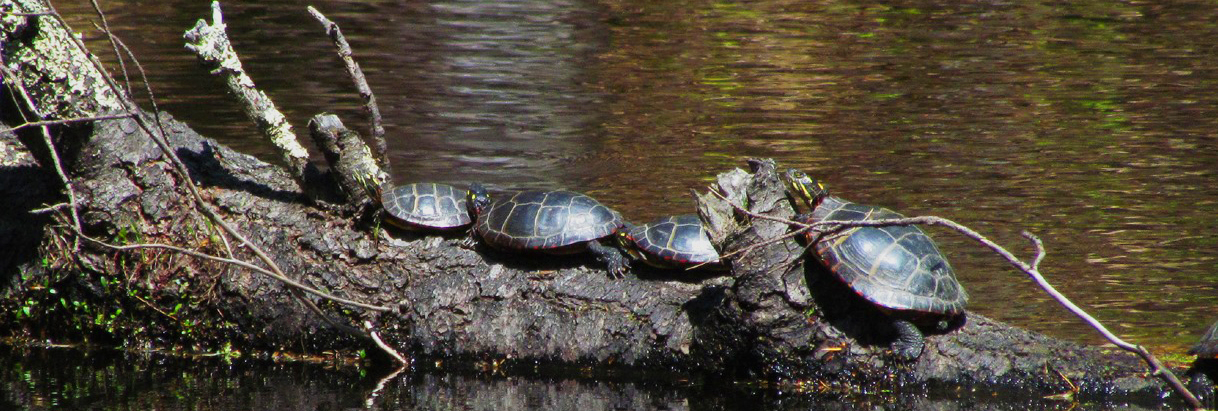Landowner Information
Landowners along the Lamprey River need to be aware that individual actions have a tremendous impact on the river, both positive and negative.
Natural Vegetation
Many varieties of native wildflowers, shrubs, vines, and trees grow along the river's banks. These plants hold soil in place and help filter pollutants found in run-off before they reach the river. Natural vegetation also provides nesting sites, cover, and food for wildlife. Trees and shrubs provide shade and help to maintain cooler water temperatures needed by fish and other aquatic animals. Even dead trees have their place as homes for a variety of cavity-nesting birds. Trees that have fallen into the water provide important habitat for fish and turtles.
Shoreland trees and shrubs also preserve the river's natural beauty and help to screen houses that face each other across the river. The loveliest views of the river from a home are often those that are filtered through ever-changing vegetation.
What You Can Do
- Maintain an area of natural vegetation between the river and your lawn or buildings that is at least 125' wide to absorb pollution and at least 300' wide to provide habitat for a range of wildlife.
- Plant or retain native, non-invasive plant species to encourage biological diversity and a healthy ecosystem. Lawns do not count as natural vegetation. Having more species of native plants will encourage more species of animals.
- Minimize the amount of pavement and other impervious surfaces such as walkways and patios. Instead, use crushed rock, stepping stones, or mulch so that water can be absorbed into the soil rather than running across its surface. Water filtered through soil is released more slowly and is cleaner when it does reach the river.
- Minimize or eliminate the use of pesticides and fertilizers. Both enter the river as run-off and pollute the water. If you must use fertilizer, use as little as possible and use a slow-release, natural fertilizer. Plants can absorb only a small amount of fertlizer. Any excess will mix with rain and head to the river as run-off. Fertilizer in water promotes excessive growth of algae and causes a cascade of problems: odors, cloudy water, low dissolved oxygen, and impaired fish habitat. The Shoreland Water Quality Protection Act prohibits the application fo pesticides or fertilizers within 25' of the river's shoreline.
- For more information, please visit http://des.nh.gov/organization/commissioner/pip/factsheets/sp/index.htm
Household Water Waste
If you are not connected to a public sewer and do not pay a municipal sewer bill, your waste water goes to a septic system. What goes down your drain goes into your septic tank, then to the leach field, and ultimately to the surrounding soil.
To keep your septic system working efficiently and to avoid expensive repairs, you must be an active guardian of the system. If your septic system does not work efficiently or fails completely, you run the risk of contaminating your land, your well, and the river's water.
What You Can Do
- Install your septic system as far back as possible from water.
- Know the location, age, and capacity of your system, and replace it if needed.
- Have a professional septic system inspection and cleaning every two to four years.
- Do not treat your toilet or sink as a garbage can. Do not dispose of grease, personal hygiene products, cigarette butts, dental floss, cat litter, medications, or miscellaneous chemicals down the toilet.
- Avoid using anti-bacterial products such as bleach or anti-bacterial soaps. Avoid chemical pipe cleaners and use non-toxic alternatives or mechanical cleaners instead.
- Outside, do not drive vehicles over the septic tank or leach field- the pressure can compact the soil and hinder proper septic system functioning. Make sure the field itself remains clear of trees or shrubs- the roots can clog the leach filed pipes. Trees and shrubs are highly desirable, however, down hill of the septic system.
-
For more information, please visit the Strafford County Conservation District at www.straffordccd.org or NH Dept. of Environmental Services at http://des.nh.gov/organization/divisions/water/wweb/homeowner_video.htm
Land Conservation
With a rapidly growing population, there is considerable pressure to develop the land along the Lamprey River, converting its many natural areas into residential or business areas. If you are interesting in ensuring that your land remains in a natural state forever, there are steps that you can take.
Private landowners typically protect their land by means of a conservation easement. A conservation easement permanently restricts development while allowing the land to remain privately owned. It is recorded as a deed and its terms are monitored by a non-profit (such as a land trust) or governmental entity (such as a town conservation commission) that is authorized to hold easements. An easement can be donated or sold, and positive tax consquences often result from the easement.
For more information, please visit the Southeast Land Trust of New Hampshire at http://www.seltnh.org/.
Public Access
The Lamprey River has several publicly owned recreational access points. In addition to these sites, many other privately owned access points allow the public to reach the river. New Hampshire has some of the best landowner liability laws in the country. Landowners who do not charge for access and have not purposely created a dangerous situation are protected from liability if a visitor is injured. The laws were enacted to encourage landowners to allow recreational uses of their land. If your Lamprey River land has a history of allowing public access for fishing, canoeing, or walking, please consider allowing public access to continue.
For more information, please visit http://www.gencourt.state.nh.us/rsa/html/XVIII/212/212-34.htm

